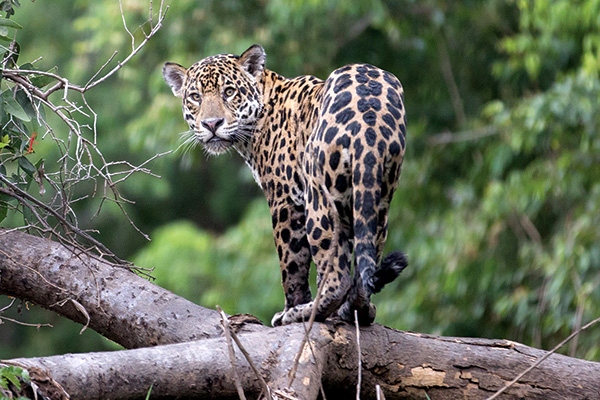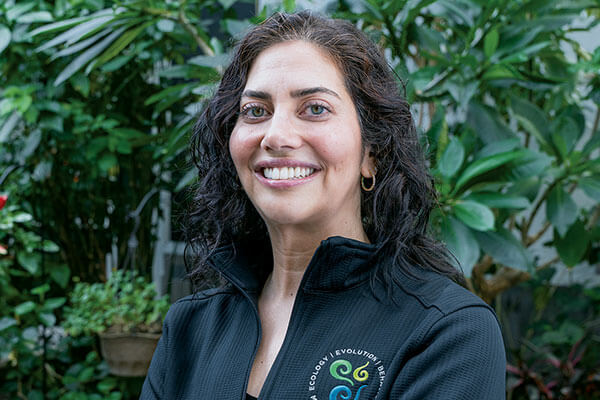Species in Crisis
Big datasets are key to beating the biggest problem in 65 million years
By Caleb Hess

Species across the planet are vanishing at astonishing rates. Insects, reptiles, fish and mammals — the abundance of life on Earth, from the depths of the ocean to high mountain peaks, is in freefall.
Wildlife populations have declined by more than 70% in the last 50 years. This is the biodiversity crisis — and it's plunging Earth into a new mass extinction.
Michigan State University ecologists are betting on data-driven solutions to save species.
Huge amounts of environmental data, from temperature readings, to satellite images, to digitized museum records, are being gathered, shared and analyzed faster than ever before.
Painting by Numbers
Research fueled by big datasets has the potential to be faster and more cost-effective while filling critical gaps that traditional research, constrained by time, space and funding, cannot.
Few people are taking advantage of these initiatives at the same scale as Lydia Beaudrot, an Assistant Professor in the Department of Integrative Biology.
The Beaudrot lab uses a variety of tools to build data-rich models that account for changes in the climate, plant life and animal populations in some of the world's richest biodiversity reserves.
From virtual-reality headsets that scan forests' structures to a global network of game cameras, Beaudrot is leveraging new technologies to better understand why tropical communities are structured in the way that they are, and how threats can disrupt them.
Scientists like Beaudrot use massive amounts of data to account for complex, interconnected factors, illustrating the nuanced relationships that species have with one another and with their shared environments. These insights can be used to develop strategies that protect multiple species more effectively.

But just because the data is available doesn't mean that it's measuring exactly what you want, or that it tells the full story.
"The data you have may not answer the question you have," said Elise Zipkin, a Quantitative Ecologist and Director of MSU's Ecology, Evolution and Behavior program. "Unlike before, we're asking questions based on the available data, rather than strictly collecting data to answer a specific question."
Zipkin explained that evolving techniques are helping make data — often stored in different formats, units and quantities — compatible, piecing together more complete pictures of ecological systems. Making data compatible is a key step in turning noise into useful mathematical models, a focus of ongoing projects in the Zipkin Quantitative Ecology Lab.
These models help untangle the deeply interconnected processes that shape ecosystems. In turn, ecologists can contribute to better strategies for protecting biodiversity.
Watching, but not waiting
That's exactly why Beaudrot and her colleagues are using more than 1,000 cameras to peer into dense tropical jungles from afar.
The cameras are managed by the Tropical Ecology Assessment and Monitoring Network, or TEAM: a global coalition of researchers tracking changes in some of the most remote and fragile ecosystems on the planet. Beaudrot's team analyzes the mountains of images gathered from protected lands across the Americas, Asia and Africa.
Analyses of data from monitoring programs such as TEAM provide "critical insights into how habitat loss and human density affect tropical forest wildlife," Beaudrot said.
Understanding change in these regions is essential to preserving global biodiversity; tropical forests contain up to half of all land-dwelling species, despite covering only 6% of the planet's surface. But human development has destroyed and fractured habitats, disrupted ecological communities and drained resources — such as access to water and cover from predators — for the animals surviving in these regions.
While protected habitats promise relief from human encroachment, it's difficult to tell whether they're having the intended effect without a wealth of data and useful models.
Even then, studying animals without disturbing them is a delicate balance. Camera traps offer a minimally disruptive way to carefully monitor populations from a distance.
Sifting through countless detailed records, recorded by unobtrusive camera traps, allows Beaudrot and her colleagues to monitor changes and measure how human activity permeates — often invisibly — into protected habitats.
"Research in my lab has revealed multiple ways in which humans are negatively impacting tropical wildlife within existing protected areas," Beaudrot said.
Better tools for a better world
Ecology has evolved as a discipline in the past century — shifting from a field based largely on descriptive observations of the natural world, to one driven by data and focused on solving complex environmental problems.

It's a shift that Zipkin attributes both to new technologies and to emerging needs.
"We needed approaches that better reflect what's happening in the real world."
MSU resources help researchers meet a rapidly evolving crisis.
Technological resources including the Institute for Cyber-Enabled Research, or ICER, and the High-Power Computing Cluster are putting cutting-edge computational tools into the hands of Spartan researchers, lowering barriers for those who want to integrate data-intensive approaches into their work.
Programs such as Ecology, Evolution and Biology and the Institute for Biodiversity, Ecology, Evolution, and Macrosystems, or IBEEM, offer interdisciplinary cohorts to scientists, providing opportunities to explore innovative techniques and collaborate on biodiversity research. These academic centers connect experts across scales and systems, leveraging shared expertise to refine research questions and approaches.
MSU ecologists are not only embracing this change, they're pushing the boundaries of research to meet evolving challenges, and they aren't the only ones.
The United States' preeminent scientific agency has gone all-in on the promises of big data for saving biodiversity, too.
The National Ecological Observatory Network, or NEON, is the highest-funded National Science Foundation project to date, composed of a network of sensors that spans the United States. At more than $430 million, it's an unprecedented investment in measuring threats to the nation's natural resources, recording changes to land use, waters, invasive species and more across 81 sites. For a decade, NEON's data has informed the work of ecologists like Zipkin and other Spartan scientists.
The work done by scientists like Beaudrot and Zipkin is crucial in shaping conservation practices supported by the most up-to-date science. Integrating research into policy is necessary for global initiatives to succeed.
Refinement and investment into these cutting-edge ecological research projects will continue to help build powerful tools for conservation, revolutionizing not just research techniques, but options for applying research to ever-evolving problems.
The College of Natural Science is committed to supporting innovative and collaborative research, connecting researchers with one another and with the revolutionary technology needed to secure a better future and build a far better world.
